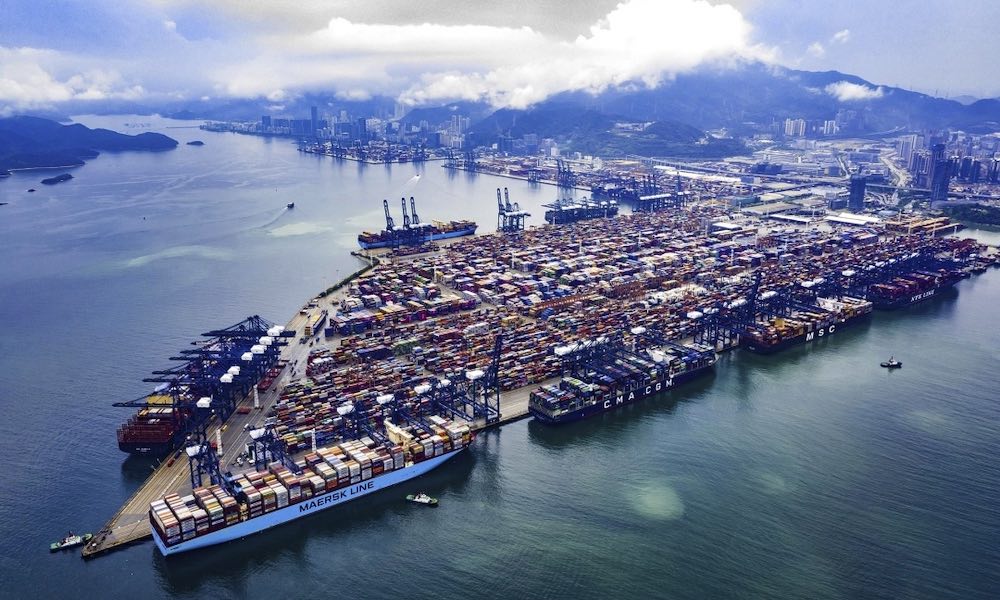The logjam of containers and ships at the Port of Yantian in China has noticeably improved in the 13 days since COVID-related safety restrictions were lifted and terminals resumed full-scale operations, but cascading delays could impact the peak holiday shipping season because dockworkers have so much cargo to dig out from, according to the world’s largest shipping line and freight data providers.
Shipping giant A.P. Møller – Maersk said in a customer notice Friday that yard density is down to 65%, which has helped improve overall productivity to 85% of normal levels. But dwell times are still unusually high, and it could take weeks to reduce piles of cargo sitting at factories heading into the crucial Christmas season for retailers, according to project44.
As of July 1, the rolling seven-day average dwell time was 12.9 days for exports and 4.2 days for inbound cargo, compared to last month’s peak of 25.4 days, the Chicago-based supply chain visibility platform reported Tuesday.
Logistics providers in China say it could take a month, or more, to clear the cargo that has backed up into warehouses and production facilities because of the congestion in Yantian.
Shenzhen’s largest port began to send home longshoremen to quarantine when COVID cases increased in late May and shut down for a six-day period before reopening to full vessel traffic on June 24. The slowdown in operations also created backlogs at the truck gates and roads leading to the port. At one point more than 40 vessels were waiting at anchorage for a berth and terminal efficiency was only 45%, according to port officials and container lines.
Congestion spilled over to other regional ports when ocean carriers diverted vessels from Yantian, but those ports have been slower to recover so far.
Data on Maersk’s website, as of Friday, shows the Port of Shekou’s yard density at 100%, Hong Kong at 93%, and Nansha at 78%, with wait times for berths ranging from three to four days.
A key reason those ports remain clogged is the behavior of carriers. The number of canceled port calls in Yantian is on the rise, reaching 17 last Thursday and 12 on Friday, project44 said. The figures are well below last month’s high of 26 blank sailings, but represent 189,203 and 107,326 twenty-foot equivalent units of cargo skipping Yantian, respectively.
Maersk, which had 19 mainline services impacted by the congestion in Yantian, decided to move the majority of arrivals to alternative ports in the area to limit the impact on the rest of its network and minimize disruption to customers’ supply chain.
Ahmed Bashir, the head of Maersk’s global execution centers, said in a YouTube message that the process of repatriating services to Yantian should be complete by the third week of July.
“We ask that you bear with us as we manage this transition. We need to ensure that it’s done in a controlled way in order to avoid creating new bottlenecks in Yantian or in neighboring ports. Our teams are working hard to recover schedules as well as resupply empty containers to the area,” he said.
The types of merchandise shipped to North America that were most impacted by the Yantian congestion were furniture and bedding, toys and games, audiovisual equipment, mechanical appliances, plastics, steel, metals, textiles, ceramics and leather, according to a new analysis by Dun & Bradstreet’s third-party risk solutions unit.
The congestion at Chinese ports of origin is only one of a series of disruptions that have buffeted ocean freight transportation since the beginning of the year. Carriers have more shipments than they can physically handle because of the booming global economy. Tight capacity was exacerbated by: ships delayed at destination ports too because of COVID restrictions and labor shortages; shipping containers not recirculating quickly enough to areas of need; a crane collapse at the Port of Kaohsiung in Taiwan temporarily knocking out some operations at a large terminal; and the Suez Canal closure for nearly a week because of a shipping accident.
Brooks Sports Inc. CEO Jim Webber on CNBC last week said the company is on an 80-day cycle for shipping compared to a normal 40 days because of supply chain issues out of Asia.
Transit times don’t account for huge order backlogs at Asian factories that are as overwhelmed by demand as the ports. With combined lead times of several months, SEKO Logistics and other freight managers are urging customers not to wait on purchase orders for the Christmas season.
Source: Hellenic Shipping






